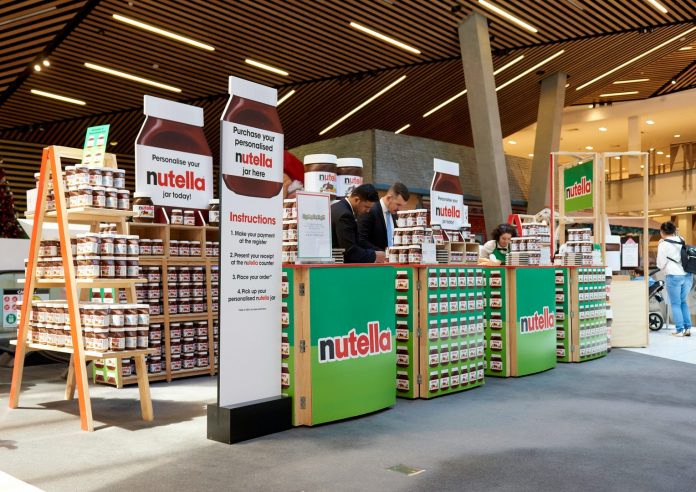
(Feature image caption: Nutella – Make it Yours – Pop up – Myer )
Let me set the scene. 2020 was the year that we were gearing up to celebrate 10 years of Shop! (formerly POPAI) Global Retail Marketing Awards in Chicago, IL, USA.
By Shop! ANZ Marketing, Events and Membership Manager Zita Watkin.
The awards were to take place in June at GlobalShop Expo. But by the end of March, Covid-19 had changed our world, and the global awards celebration including a wonderful showcase of POP displays was transitioned to an online event.
My annual trip to the US to see the best of the best retail marketing activations was put on hold. I needed to pivot!
Knowing how much retail transformation has occurred over the last 10 years, I set about to create a research piece to understand our path to now and think about how we can leverage this to create amazing retail shopping experiences in the future.
The following trends and insights story is a snapshot of my findings.
Ten years of retail display innovation
The last 10 years have seen major technology-based innovations that have changed the way that we shop.
To set the scene, Apple introduced iPad’s in 2010, and mobile phones became a shopping tool.
Almost overnight, we had more options and ways to buy what we want.
These alternatives to instore shopping did not kill physical stores. Quite the opposite! Online shopping upped the ante for physical retail marketing. And omnichannel marketing is more important today than ever.
But some of the biggest changes have not been brought about from technology, but rather the fact that we are seeking more personal and human connections and experiences.
Here are some themes driving retail display innovation illustrated by examples.
- ‘Phygital’ – phones and physical
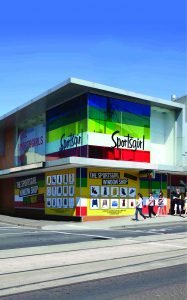
One of the biggest changes of the last decade has been the fusion of traditional brick and mortar shopping with mobile phones.
In 2011, Sportsgirl’s flagship store in Chapel Street, Melbourne shut its doors temporarily whilst major renovations were undertaken. Sportsgirl saw an opportunity to do something both truly trailblazing and innovative whilst keeping sales rolling in.
Sportsgirl launched ‘Window Shop’, which allowed customers to purchase products without entering the store.
At the time, mobile sales were a relatively new service for the 50-year-old retailer. The ‘Window Shop’ execution was critical in driving awareness and customer education about the brands mobile and tablet shopping. It also assisted in driving awareness and customer education in QR functionality; cementing Sportsgirl’s place as the nation’s leading fashion mobile-retailer in Australia.
- Reinventing category
Category management has had a major makeover, addressing consumer behaviour and making shopping a far more engaging and collaborative brand experience.
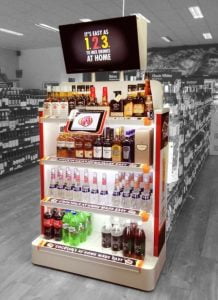
This new strategy means that shopping aisles are becoming in-store ‘micro destinations’, creating a one-stop shopping experience that drives growth for the whole category regardless of the brand that might be taking the upper hand in the activation.
A great example of this can be seen in the ‘Mixxit@Home Cocktail Display’ launched in 2012.
Since the late 1990s, much of the innovation in retail’s liquor sector had been product-based pre-mix solutions. But in 2011-12, due to the popularity of shows like Masterchef, creating gourmet meals at home and interest in mixing cocktails was having a resurgence.
Coca-Cola Amatil created a retail solution that delivered cocktail recipes made easy with a full suite of ingredients utilising an interactive touch screen display.
Mixxit@Home became a central destination shopping experience, and a brand new “cocktail couture” category for bottle shop aisles.
- Iconic displays
You know you are onto a good thing when a display is created that reflects brand in an iconic way and is repeated year on year.
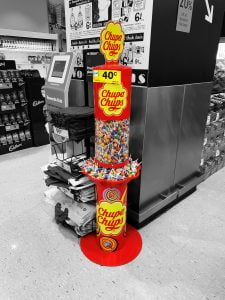
Two examples that come to mind are the iconic oversize 7-Eleven ‘Slurpee Cup Dump Bin’ and the Chupa Chups totem.
Both of these displays have some award-winning similarities; representing brand exceptionally well and have 360-degree shopability.
This means that the displays can be used in any location and easily visible anywhere instore.
Versatility and making the brand the hero are two key ingredients to expose brand and product to shopper traffic – turning shoppers into buyers!
- Personalisation, partnerships, pop up brands, and online goes physical!
Without a doubt one of the biggest trends that exploded into the retail space in 2015 and keeps getting bigger is ‘product personalisation’.
One of the most memorable examples of personalisation has been Nutella’s ‘make it yours’ campaign. But this campaigns success extends far beyond personalisation utilising partnerships and the physical shopper space to really drive engagement.
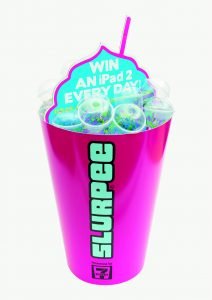
The personalisation product was not new. Nutella’s manufacturer Ferrero had previously created a product personalising service that was available via social media platforms but bringing it to life through engaging pop ups at Christmas was key to its commercial success.
Myer saw the potential in offering the Nutella ‘make it yours’ personalisation service instore as part of their Giftorium Christmas campaign. It was also a unique opportunity to partner with Ferrero.
Myer’s aim was to bring traffic to stores by exciting customers with theatre and customisation.
Personalised Nutella jars were the largest single selling gift item in Australia for Christmas 2015.
Unsurprisingly Nutella was Myer’s top-selling item at Christmas this year.
- Storytelling with interactive experiences
Wine is an amazing category when it comes to instore marketing opportunities.
It’s different to other categories. Yes, shoppers choose wine based on brand and price like other categories, but the other key shopper driver is ‘packaging’. In other words, many people choose a wine based on label alone!
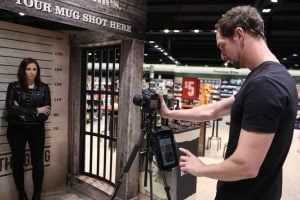
So, for wine, possibly more than any other category, the big opportunity for brand switching happens instore, with packaging, display and experience.
Who can forget Treasury Wine Estates’ ‘19 Crimes’ campaign in 2017. The global ‘Living Wine Labels’ AR app brought wine labels to life with “historical stories direct from the infamous”.
19 Crimes quickly became the fastest selling wine NPD over $10 ever launched in First Choice Liquor.
The 19 Crimes story keeps evolving. In 2018-19 a follow-up activation was created; ‘Get Your Mug Shot Taken & Join the 19 Crimes Gang’. Personalised wine labels were printed onsite after “mug shots” were taken of shoppers in a mock rustic jail cell photobooth display; a fun and engaging way for shoppers to engage with the brand.
19 Crimes has seen phenomenal success both locally and in the US. Today it is a benchmark of success for its ingenious usage of brand, personalisation and disruptive displays to win shoppers over.
In conclusion
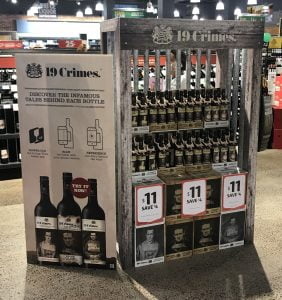
These POP display examples from our recent history demonstrate the shift in brands increasingly creating retail displays with human interaction and product experience at top of mind.
Looking back allows us to think about them differently and ponder this thought,
“How can we harness the retail display to give shoppers a more premium shopping experience?”
One thing is clear. We need to take advantage of digital and shopper themes to deliver highly personalised consumer experiences instore at any scale.
10 POP display trends from the last 10 years
- Iconic stands
- Phones and physical
- Interactive experiences
- Make it personal
- Storytelling
- Sensory experiences
- Creating moments
- Perfect partners
- Reinventing category
- Online goes physical
About Zita Watkin
Zita Watkin has 20 years’ experience in design and marketing, working with Australia’s top creative and manufacturing businesses; servicing iconic retailers and brand clients.
Zita travels internationally to GlobalShop and Euroshop, keeping up to date with the latest retail marketing trends and case studies, returning to share findings with Shop! ANZ members.
Today, Zita works alongside Shop! creating content for members and curating marketing and events. She also runs her own consultancy, Zita Creative Marketing, working on strategic marketing for retail B2B clients.
About Shop! ANZ
Formerly known as POPAI, Shop! is the only global, not for profit industry association exclusively advocating for excellence in shopper marketing and retail experience. With 20 offices covering 45 countries and over 1700 member companies worldwide, Shop! brings global best practice intelligence, resources, recognition and networks and to our members. For more information, visit www.popai.com.au or email www.shopassociation.org.au.



